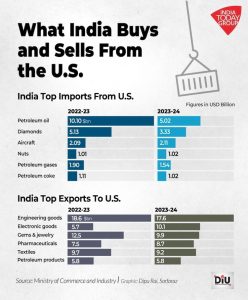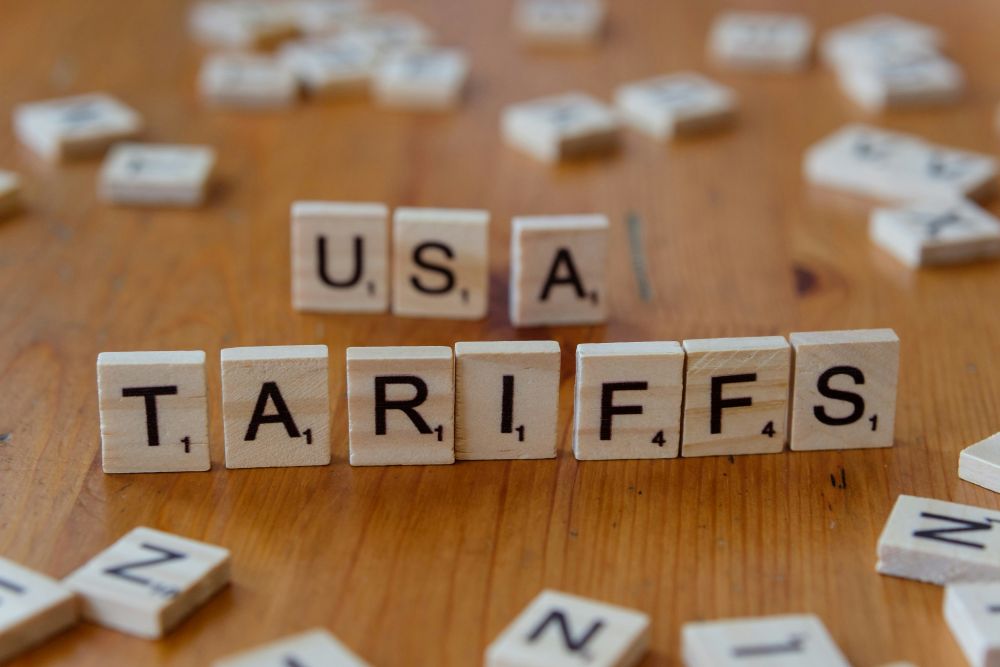Last week, on April 2nd, US President Donald Trump announced sweeping trade/import tariffs (taxes on goods and services bought from other countries) on 60 of the worst offending countries with which the US had significant trade deficits. To fully understand this issue, we need to understand its backdrop.
Since decades, America has been facing –
- Unsustainable fiscal deficits (Government spending being more than its earnings).
- Decline as a manufacturing hub for most goods and services (choosing to import and consume rather than produce locally), thereby having very high current account deficits.
- Continuously increasing Debt-to-GDP ratio.
(GDP, or Gross Domestic Product, is the total monetary value of all goods and services produced within a country’s borders over a specific period. It’s the size of a country’s economy. The bigger the GDP, the more economic activity in that country. The debt-to-GDP ratio is a key economic metric that compares a country’s national debt to its gross domestic product (GDP). It’s usually expressed as a percentage and helps indicate how well a country can manage or repay its debt.
A lower ratio suggests the country produces enough economic output to service its debt comfortably. A higher ratio can be a red flag—it means the country owes more than it makes in a year, which could raise concerns about financial stability or creditworthiness.)
After taking over as President in January 2025, President Trump chose to first look at the fiscal deficit issue and reduce government expenditure by reducing a significant number of government employees and altogether closed the well-known USAID funding to developing countries. He also set up the DOGE committee to come up with further suggestions and measures to rationalise government expenditure.
Next, to reduce the current account deficit with the ultimate objective of making America a manufacturing hub once again, President Trump decided to take the bull by its horns by attempting a drastic course correction. As a first major step, he has announced across the board reciprocal import tariffs of 10% on all imports, as well as country-specific tariffs proportionate to the US’s trade deficit with each of them. Also, he has targeted non-tariff barriers and practices being followed by many of these countries, such as currency manipulation, dumping of goods at low prices, using unfair practices like sweat/child labour, etc.
Countries such as China have retaliated by increasing their tariffs (on imports from the US) to match the 34% imposed on them, and the US has further increased its tariff to 104%, subsequently increased to 125% with immediate effect. The EU is also contemplating retaliation measures on imports of both goods and services from the US.
So far, around 50 countries have come forward to negotiate their high tariffs with the US, hoping to find a solution soon and avoiding adverse consequences for both the US and the world.
It is well known that higher import tariffs will increase inflation for US consumers and create shortages of finished and semi-finished goods and raw materials because of disruptions in the supply chain worldwide. Businesses and stock markets worldwide fear that the current tariffs and trade war will lead to inflation and recession in the US and its ripple effect on the rest of the world.
Stock markets in the US and worldwide have been very volatile, wiping off USD 13 trillion since the announcement, essentially reacting to the trade war, especially with China, and the uncertainty concerning negotiations with affected countries.
In his attempt to cut the fiscal deficit, President Trump is certainly not the first US President to do so. President Clinton, in the late 1990s’s the government employee count by more than 400,000, and the fiscal deficit also turned into a surplus, perhaps for the last time since then. However, their approaches to effecting this change have been vastly different, while Clinton followed a consultative and calibrated approach, Trump’s has been quite the opposite.
Impact on India
–
India’s trade deficit with the US stood at $28 billion in FY24. While the reciprocal tariffs primarily target sectors such as steel, aluminium, and technology, their implications extend far beyond these industries, reshaping India’s exports, domestic manufacturing, and strategic economic partnerships.
The impact of these tariffs will vary across different sectors. The Export-Import Bank of India (Exim Bank) has said that the reciprocal tariff on India is a mixed bag for the country, with sectors like electrical machinery, textiles and apparel, leather, and footwear benefiting while impacting machinery and mechanical appliances, automobile, and iron and steel exports.
While India’s IT services exports are likely to get hit with US clients cutting expenditure due to economic turmoil in the US, the impact of the tariffs on labour-intensive sectors such as textiles, footwear, and agriculture is likely to be a big worry. Some sectors, such as pharmaceuticals and semiconductors, have escaped the retaliatory levy as yet, which has mitigated the impact for now.
What needs to be factored in is that the reciprocal tariff imposed on India is moderate compared to many other Asian countries. India has been slapped with a 26% tariff, lower than China (104%), Taiwan (32%), Bangladesh (37%), Vietnam (46%), and Thailand (37%). Though reciprocal levies will sharply increase the total tax on India’s exports, this may not pinch much as India’s competitors face even higher effective tax on their shipments to the US. India’s lower dependence on exports is also likely to partly shield it from the effects of the higher tariffs, unlike many other Asian countries, including China.
According to the latest RBI estimates, India’s GDP is expected to grow by 6.5% in FY26. Many think India might suffer more from the global economic turmoil due to trade wars than from the tariffs imposed on the country by Trump.
Hope for a deal
Discussions are ongoing between Indian and US trade teams for the expeditious conclusion of ‘The Bilateral Trade Agreement’ (BTA), as the two sides already aim to conclude the first tranche of the pact by the last quarter of this year, which could be used to deal with the reciprocal tariffs to get them rescinded or settle them bilaterally.
The Trump administration said that, its International Emergency Economic Powers Act of 1977 (IEEPA) also allows some exemptions. India could potentially get these exemptions once the trade deal is in place.
Net Net…
Donald Trump has set out to change the world economic order and is running the US like a ruthless businessman. As things stand now, the initial high tariffs seem to have jolted the world and set a framework for them to come to the negotiating table. His allies are aghast, and China may or may not blink with his shrill rhetoric.
He has announced 90-day tariff relief on every country except China. Presumably, to negotiate a deal bilaterally with every country. This has sparked a relief rally until he makes a new announcement and rattles the world. As the world adjusts to this new reality and its impact on supply chains, it’s hard not to criticise his methods. The faith in the famed US institutions for their checks and balances is eroding.
India has tried to be in the US’s good books and may be relatively less damaged, as our manufactured exports are only 2% of the GDP. Ironically, our higher cost base, uncompetitiveness, and large domestic-facing economy will rescue us.
Financial markets will see-saw based on the incoming news flows. This is going to be a tough year.


No Comment